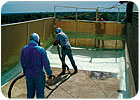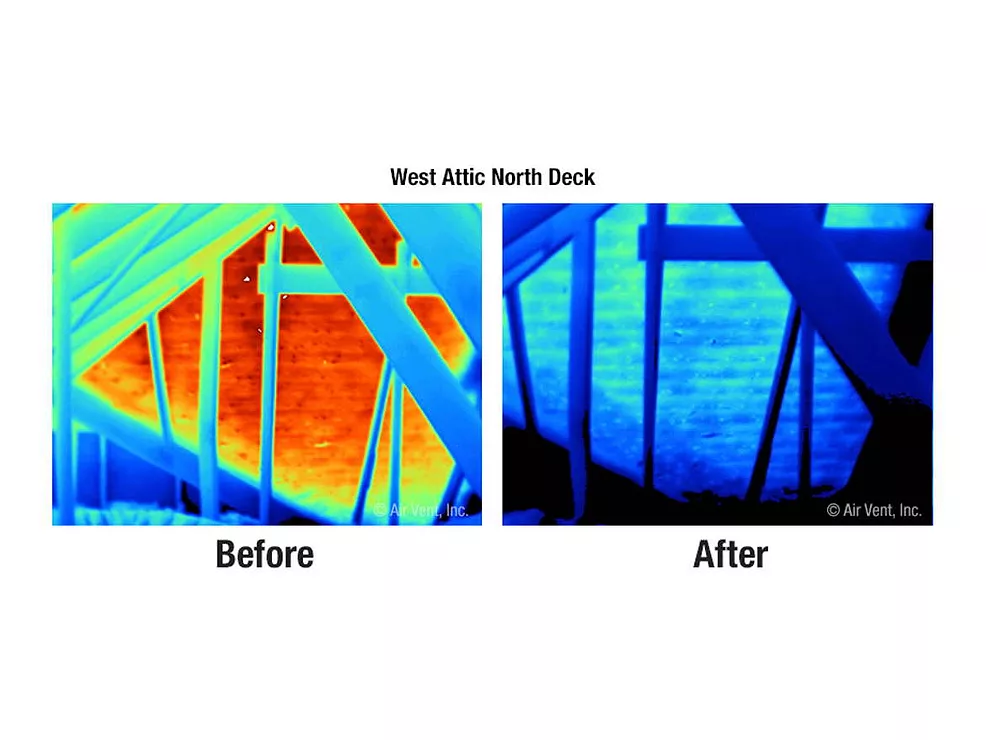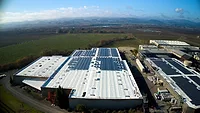Spreading the Benefits of Spray Foam
The versatility of spray foam roofing has created some excellent market avenues for producers and applicators. Certainly roofing accounts for a significant portion of spray polyurethane foam (SPF) consumption, but there are growth areas for residential insulation and "green" coatings.

The versatility of spray foam roofing has created some excellent market avenues for producers and applicators. Certainly roofing accounts for a significant portion of spray polyurethane foam (SPF) consumption, but there are growth areas for residential insulation and "green" coatings. Applications like adhesion for board insulation and roof tiles are spreading the benefits of spray foam to more roofing contractors. Add on the energy savings that can be achieved by spray polyurethane foam - plus the small nudge that tax credits are giving and the fact that the long transition to new blowing agents is over - and the future for gleaming white roofs with high insulation levels is bright indeed.

A prominent symbol for the destructive force of Hurricane Katrina, the 9.7-acre roof received emergency repairs from Brazos Urethane last October. Even before the bid was officially awarded in February, the company bought four new Graco/Gusmer H-20/35 sprayers, thousands of feet of hose and several pumps. The job was completed within 15 days, winning Brazos Urethane substantial bonuses.
High-profile jobs like the Superdome can raise the awareness of spray foam in different markets. Residential builders are looking for improved properties of insulation, like higher R-values, resistance to mold, noise reduction, and better air quality fundamentals. Rising energy bills are encouraging contractors to offer spray foam for insulation in walls and attics.
"Certainly the energy issues are focusing the interest in insulation," says Bill Hrynkiewicz, market development manager for Graco/Gusmer. He adds that health concerns about other insulation options are also on the consumer's radar. "From our point, the regulatory agencies are saying that some of the other insulations are maybe carcinogenic."
Increased awareness of concerns over issues like indoor air quality is helping spur the use of spray foam. According to Hrynkiewicz, mold is such a liability for the insurance industry that some companies are using homeowners' policies to restrict some building materials. Even the acoustical properties of foam are being promoted to improve the "feel" of a house. All of these trends have led to the development of new equipment to meet the growing demand, like safeguards that were formerly used only in highly sensitive applications.
"One of the big things that's happening is...you're seeing the continuation of those technologies which become more contractor friendly," says Hrynkiewicz.
Gauges can track pressure, temperature and chemical usage to ensure adequate coverage with coatings. Sprayers can be used for multiple components, and new guns use less hydraulic fluid. In 2003, Gusmer introduced a new tip for adhering roof tiles. The larger droplets of SPF combined with a different formulation have created a superior adhesive for installing tiles that has won over even the most stubborn installers. With no screws, no penetrations and superior wind uplift characteristics, some roofing contractors may find themselves contemplating the merits of spraying foam on top of the roof for the next low-slope job.

"When we did some research on this as part of an EPA grant ... the properties reported were remarkably consistent with the old blowing agent," says Mason Knowles, executive director for the Spray Polyurethane Foam Alliance (SPFA), a trade organization based in Fairfax, Va.
Verifiable test results are important to getting the word out about the energy savings that foam offers and the SPFA is confident about promoting an aged R-value of 6 per inch of SPF. Because there are some many variables as to how a building envelope performs in real life, measuring the success of insulation is not as cut and dried as judging the repair of a leaking roof. However, SPF has decades of history and is actively promoting itself as an alternative to standards in home insulation like fiberglass.
The efforts appear to be paying off. According to a market survey conducted by the Alliance for the Polyurethanes Industry, total demand for rigid spray polyurethane foam between 2002 and 2004 increased by 40.6 percent. While still a small portion of the market, the tremendous interest in energy efficiency is opening up new avenues for spray foam. Foam manufacturers are using their Web sites to reach out to average consumers with FAQs and links to tax savings calculators. (For some examples, see the Web sites at end of this article.) Knowles says the SPFA is constantly fielding requests from homeowners and is focusing on getting the word out to end users.
"Residential wall insulation is a key target for our promotions committee," he says. He gets twice as many calls from homeowners compared to contractors. "Judging by the number of calls I get about activity, I expect that trend to continue more and more."
New construction is certainly the best time to install foam, but the retrofit market presents some excellent opportunities as well. The industry still needs exposed wall cavities for something that expands 30 to 50 times it's original size, but foam producers and equipment manufacturers are looking to crack open that market without cracking open the walls. Knowles replaced his old fiberglass insulation in his own attic with foam. Even with a lower R-value, the energy savings were significant, humidity didn't fluctuate wildly and the temperature difference between the basement and the second floor was only 2 degrees. It used to be 8 to 10 degrees.
"Just the comfort level by itself made a huge difference," he says.

"Typically, it's going to be expensive to get that $1.80," says Tim Leonard, CEO of ER Systems in Rockford, Minn. However, plain old energy savings are driving plenty of sales. "We have projects that are over 4 inches of foam. That's the energy savings they want. They weren't looking for tax credits."
His company is helping to spread the word, and one method involves partnering with Trane on projects certified by Leadership in Energy and Environmental Design (LEED). In 2002, the company launched its Prairie Tech line of products that contain recycled components in a growing effort to help building owners obtain financial incentives as well as lower power bills. Cities are offering credits for roofs that contain storm water and green roofs are an obvious solution.
ER Systems has installed a number of roof top gardens using Polyurea as the membrane. There are added energy savings from having soil and plants buffer the temperatures, but projects like this are primarily in the demonstration phase. Still, more creative solutions in resource conservation are continually being developed, along with initiatives that encourage their use in every day applications.
In fact, some of the reluctance to use credits, deductions and rebates may stem from the sheer number of programs available today. This is one area where roofing contractors can help clients find the best instruments and show how the new roof can ultimately pay for itself, getting the building owner to finally pull the trigger.
"You don't necessarily time your project based on incentives. You do the project and see what incentives there are," says Leonard. "Right now, they're probably the highest they've ever been, related to energy."
For more information, visit www.sprayfoam.org, www.energytaxincentives.org, www.ornl.gov/sci/roofs+walls/insulation/ins_16.html, or www.dsireusa.org.
Manufacturer Gaco Western Inc. found the company could accomplish all of its key performance objectives by incorporating Transcend® Additive Technology into its HFC-245fa blends. "Transcend fits for us. We began using it in 2005 and today we use it in just about all of our foam formulations," said Irene Schwechler, Vice President & General Manager for Midwest Operations for Gaco Western, which sells all across the country, both direct to contractors and through its distributor network. "Our foam business is expanding, and our products have wide acceptance in the market. Transcend has really helped us in our transition into 245fa foams."
"Transcend Additive Technology is a proven approach to improve next-generation foam technologies," said Kirsten Makel, North American Business Manager for Arkema's Foam & Solvents Business. She noted that it delivers improved solubility of blowing agents in polyols and reduces viscosity, thus improving the flow characteristics of many foam formulations. "Transcend also reduces smoke generation and flame spread," she said.
The Transcend additive is based on trans-1, 2-dichloroethylene, and can be added to Hydrocarbon (HC) and HFC foam formulations to create unique foam products. Arkema offers an interactive calculator, available on CD or via the Internet, to show formulators the monetary savings they can realize by using Transcend Additive Technology in their foam formulations. Producers can enter raw material costs for all their formulation components and determine the specific economic advantage that they can realize by using Transcend.
For more information about the product, visit www.arkemagroup.com or www.arkema-inc.com.

The versatility of spray foam roofing has created some excellent market avenues for producers and applicators. Certainly roofing accounts for a significant portion of spray polyurethane foam (SPF) consumption, but there are growth areas for residential insulation and "green" coatings. Applications like adhesion for board insulation and roof tiles are spreading the benefits of spray foam to more roofing contractors. Add on the energy savings that can be achieved by spray polyurethane foam - plus the small nudge that tax credits are giving and the fact that the long transition to new blowing agents is over - and the future for gleaming white roofs with high insulation levels is bright indeed.

Polyurethane foam is an integral component of many ecologically friendly roofing projects, including this garden roof installation. (Photo courtesy of ER Systems Inc.)
Spray Is on a Roll
Graco/Gusmer, an equipment company with roots dating back to 1926, is reaching a high point these days. After Graco completed the acquisition of competitor Gusmer in 2005, the company has seen a surge in demand for SPF in residential projects. New tools are being developed to address growing applications while traditional large-scale projects keep rolling. Probably the biggest seal of approval came when Brazos Urethane of Texas City, Texas, won the $32 million bid to reroof the Louisiana Superdome.A prominent symbol for the destructive force of Hurricane Katrina, the 9.7-acre roof received emergency repairs from Brazos Urethane last October. Even before the bid was officially awarded in February, the company bought four new Graco/Gusmer H-20/35 sprayers, thousands of feet of hose and several pumps. The job was completed within 15 days, winning Brazos Urethane substantial bonuses.
High-profile jobs like the Superdome can raise the awareness of spray foam in different markets. Residential builders are looking for improved properties of insulation, like higher R-values, resistance to mold, noise reduction, and better air quality fundamentals. Rising energy bills are encouraging contractors to offer spray foam for insulation in walls and attics.
"Certainly the energy issues are focusing the interest in insulation," says Bill Hrynkiewicz, market development manager for Graco/Gusmer. He adds that health concerns about other insulation options are also on the consumer's radar. "From our point, the regulatory agencies are saying that some of the other insulations are maybe carcinogenic."
Increased awareness of concerns over issues like indoor air quality is helping spur the use of spray foam. According to Hrynkiewicz, mold is such a liability for the insurance industry that some companies are using homeowners' policies to restrict some building materials. Even the acoustical properties of foam are being promoted to improve the "feel" of a house. All of these trends have led to the development of new equipment to meet the growing demand, like safeguards that were formerly used only in highly sensitive applications.
"One of the big things that's happening is...you're seeing the continuation of those technologies which become more contractor friendly," says Hrynkiewicz.
Gauges can track pressure, temperature and chemical usage to ensure adequate coverage with coatings. Sprayers can be used for multiple components, and new guns use less hydraulic fluid. In 2003, Gusmer introduced a new tip for adhering roof tiles. The larger droplets of SPF combined with a different formulation have created a superior adhesive for installing tiles that has won over even the most stubborn installers. With no screws, no penetrations and superior wind uplift characteristics, some roofing contractors may find themselves contemplating the merits of spraying foam on top of the roof for the next low-slope job.

Some energy-conscious building owners looking to SPF for its insulation properties are also lookin ginto solar applications with renewed interest. (Photo courtesy of ER Systems Inc. and Prairie Technologies Inc.)
Agent of Change
January 2005 was the last time foam manufacturers could use the old HCFC blowing agents. This isn't the first time there's been a dramatic shift, but the industry took it in stride. The third-generation blowing agent, HCFC-245fa, has been thoroughly tested to confirm aged properties."When we did some research on this as part of an EPA grant ... the properties reported were remarkably consistent with the old blowing agent," says Mason Knowles, executive director for the Spray Polyurethane Foam Alliance (SPFA), a trade organization based in Fairfax, Va.
Verifiable test results are important to getting the word out about the energy savings that foam offers and the SPFA is confident about promoting an aged R-value of 6 per inch of SPF. Because there are some many variables as to how a building envelope performs in real life, measuring the success of insulation is not as cut and dried as judging the repair of a leaking roof. However, SPF has decades of history and is actively promoting itself as an alternative to standards in home insulation like fiberglass.
The efforts appear to be paying off. According to a market survey conducted by the Alliance for the Polyurethanes Industry, total demand for rigid spray polyurethane foam between 2002 and 2004 increased by 40.6 percent. While still a small portion of the market, the tremendous interest in energy efficiency is opening up new avenues for spray foam. Foam manufacturers are using their Web sites to reach out to average consumers with FAQs and links to tax savings calculators. (For some examples, see the Web sites at end of this article.) Knowles says the SPFA is constantly fielding requests from homeowners and is focusing on getting the word out to end users.
"Residential wall insulation is a key target for our promotions committee," he says. He gets twice as many calls from homeowners compared to contractors. "Judging by the number of calls I get about activity, I expect that trend to continue more and more."
New construction is certainly the best time to install foam, but the retrofit market presents some excellent opportunities as well. The industry still needs exposed wall cavities for something that expands 30 to 50 times it's original size, but foam producers and equipment manufacturers are looking to crack open that market without cracking open the walls. Knowles replaced his old fiberglass insulation in his own attic with foam. Even with a lower R-value, the energy savings were significant, humidity didn't fluctuate wildly and the temperature difference between the basement and the second floor was only 2 degrees. It used to be 8 to 10 degrees.
"Just the comfort level by itself made a huge difference," he says.

HCFC blowing agents were phased out in January 2005, and the industry has switched over to third-generation blowing agents such as HCFC-245fa. (Photo courtesy of Arkema.)
Possible Tax Benefits
Numerous tax incentives, like tax credits being offered through the Energy Policy Act of 2005, are not making Knowles' phone ring, but that may change. As taxpayers go over their liabilities for this year, their accountants might be the driving force to look at capital investments that qualify for excellent returns. States and utilities are offering rebates to homes and businesses, like residential customers of Alliant Energy in Minnesota, who can get back up to 70 percent of the cost of attic insulation. Commercial buildings that exceed the ASHRAE Standard 90.1-2001 for energy savings by 50 percent can qualify for a tax deduction of $1.80 per square foot; more modest requirements can qualify for 60 cents per square foot."Typically, it's going to be expensive to get that $1.80," says Tim Leonard, CEO of ER Systems in Rockford, Minn. However, plain old energy savings are driving plenty of sales. "We have projects that are over 4 inches of foam. That's the energy savings they want. They weren't looking for tax credits."
His company is helping to spread the word, and one method involves partnering with Trane on projects certified by Leadership in Energy and Environmental Design (LEED). In 2002, the company launched its Prairie Tech line of products that contain recycled components in a growing effort to help building owners obtain financial incentives as well as lower power bills. Cities are offering credits for roofs that contain storm water and green roofs are an obvious solution.
ER Systems has installed a number of roof top gardens using Polyurea as the membrane. There are added energy savings from having soil and plants buffer the temperatures, but projects like this are primarily in the demonstration phase. Still, more creative solutions in resource conservation are continually being developed, along with initiatives that encourage their use in every day applications.
In fact, some of the reluctance to use credits, deductions and rebates may stem from the sheer number of programs available today. This is one area where roofing contractors can help clients find the best instruments and show how the new roof can ultimately pay for itself, getting the building owner to finally pull the trigger.
"You don't necessarily time your project based on incentives. You do the project and see what incentives there are," says Leonard. "Right now, they're probably the highest they've ever been, related to energy."
For more information, visit www.sprayfoam.org, www.energytaxincentives.org, www.ornl.gov/sci/roofs+walls/insulation/ins_16.html, or www.dsireusa.org.
Sidebar: Gaco Western Uses Arkema Additive in SPF Blends Designed for Roofing Insulation Applications
Things just haven't been the same for spray polyurethane foam formulators and their customers since HCFC-141b foams have gone away. While many formulators have looked to HFC-245fa, many still find they need to do more work to reduce viscosity, reduce vapor pressure and to improve solubility in their HFC-245fa-based foam formulations.Manufacturer Gaco Western Inc. found the company could accomplish all of its key performance objectives by incorporating Transcend® Additive Technology into its HFC-245fa blends. "Transcend fits for us. We began using it in 2005 and today we use it in just about all of our foam formulations," said Irene Schwechler, Vice President & General Manager for Midwest Operations for Gaco Western, which sells all across the country, both direct to contractors and through its distributor network. "Our foam business is expanding, and our products have wide acceptance in the market. Transcend has really helped us in our transition into 245fa foams."
"Transcend Additive Technology is a proven approach to improve next-generation foam technologies," said Kirsten Makel, North American Business Manager for Arkema's Foam & Solvents Business. She noted that it delivers improved solubility of blowing agents in polyols and reduces viscosity, thus improving the flow characteristics of many foam formulations. "Transcend also reduces smoke generation and flame spread," she said.
The Transcend additive is based on trans-1, 2-dichloroethylene, and can be added to Hydrocarbon (HC) and HFC foam formulations to create unique foam products. Arkema offers an interactive calculator, available on CD or via the Internet, to show formulators the monetary savings they can realize by using Transcend Additive Technology in their foam formulations. Producers can enter raw material costs for all their formulation components and determine the specific economic advantage that they can realize by using Transcend.
For more information about the product, visit www.arkemagroup.com or www.arkema-inc.com.
Links
Looking for a reprint of this article?
From high-res PDFs to custom plaques, order your copy today!







